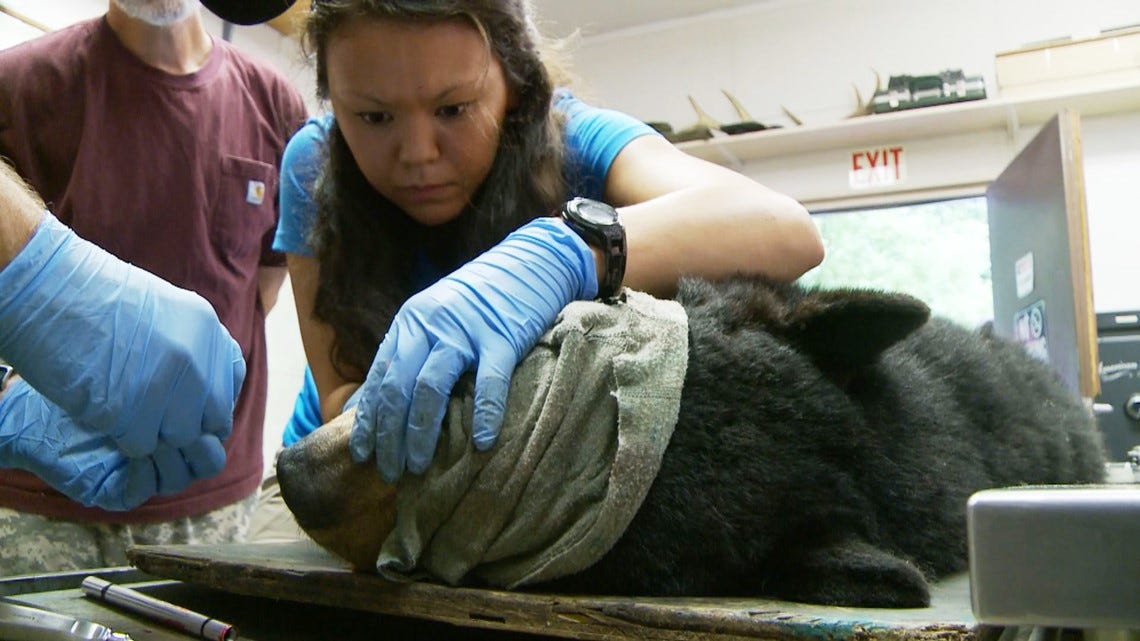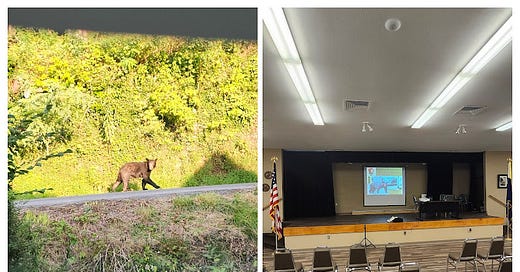On Tuesday morning, August 13, myself, along with about 50 area residents were on hand for an open house and presentation on Black Bear safety and management in Gatlinburg. I felt this was an important outreach and gave people a chance to discuss concerns, ask questions, and learn more about what the City of Gatlinburg is doing in partnership with other organizations: Tennessee Wildlife Resources Agency, BearWise, and the National Park Service, among others. Representatives from the Appalachian Bear Rescue were also present.
The headliner for the Open House held at the American Legion was Ryan Williamson, Wildlife Biologist for the National Park Service. He has roots in the area, as he was born and raised in nearby Cocke County, so I would say that alone qualifies him as someone who is well aware of bears before he went into his professional work in the Great Smoky Mountains National Park.
He began by stating that “we will never reach everyone,” and this sort of honesty was appreciated from the get-go. It’s sad but true. However, by reaching as many people as possible, we can make a tangible difference in protecting our precious black bears.
The beginning of the slideshow was a showing of ways the National Park Service began their trash program. In the 1950’s and 60’s, bear interactions surged and resulted in the implementation of small roadside trash cans by the 1970’s that quickly turned disastrous, as they filled quickly, meaning piles of trash accumulated outside the bins where bears could easily pick through. These small, ineffective bins were replaced by larger volume ones…but they also came with their own set of problems: people were injured, some with amputated fingers as the result of lids closing on people loading them, so safer measures were added to alleviate human error. As you can see, this wasn’t—and in some ways still today—not a perfect system that requires constant retooling.

As far as the bears themselves, there are 4 stages people like Ryan from the Park Service observe from a bear behavior perspective. The first is one that is of ideal behavior we want to see from bears—Wild. This means they have a natural fear of humans and will run away if they feel threatened.
The second is Habituated, in which Ryan used the paparazzi following a major movie star. In both cases people are constantly watching—as with bears here in the Park—but they can live with the attention. Therefore, they’ve lost their fear of humans.
The third involves an advanced danger from humans and bears—Food Conditioned. This is where bears seek out food from humans. As indicated with recent real-life episodes, bears are one-time learners, as is the case with people. If they know where to go for food, they’ll return to that spot.
The worst kind of bear behavior is Predatory for obvious reasons. When bears see people as a food source, they cannot revert back, and this turns into dangerous encounters where bears act as predators to get what they want.
The Park Service uses three methods for bear management: Aversive Conditioning, Capture Release Onsite, Capture and Relocation, and Euthanasia. The former involves tactics they use to scare away black bears, including paintball guns, tasers, and firecrackers. The middle ones they have purposefully used to educate the public, as evidenced with recent footage they filmed from Chimney Tops picnic area of them letting loose a bear they recently tagged. These bears are now identified as “Human Conflict Bears,” instead of the old “Nuisance Bear” moniker for their monitoring purposes.
Speaking of monitoring, the Park Service works in tandem with many different agencies and organizations, and this has led to great strides in the utilization of technology with their efforts. In 2015, they started using GPS collars—created by a UT Knoxville graduate student, Jessica Braunstein—to monitor the bears in the park, which numbered 1,909 by their recent estimation.

There was some shocking news that came from this. It showed the bears were willing to travel dozens of miles to find a food source, and would actually return to the same place they came from in the park. In one case, a female bear and her two cubs traveled from Elkmont in the Smoky Mountains to Sevierville—a 36 mile trek—in only a few days.
This has redefined the whole front-country and back-country bear theory. But in fact, this recent technology has shattered those beliefs. Now we know 95% of male bears leave the park at some point, and around 50% of females do as well, which takes us back to the importance of staying bear aware.
The collar technology has been huge in gaining a much better understanding of just how bears roam, but ideally, it is up to US! as individuals to be smart with our own behaviors. If a bear has jumped your picnic table to get your food, this bear cannot revert back to its initial Wild bear behavior. He is now a threat to humans and cannot be relocated. And as tough as it may sound, euthanasia is the last resort that’s utilized. Why, again? There is no “farther and deeper.” These bears will return and continue to cause potential havoc on residents and visitors.
In conclusion, Williamson stressed that they do not like killing bears. This should be obvious to anyone who knows how hard and dedicated the people from the Park Service, like Ryan, work to preserve its natural resources and wildlife. While there will never be total cooperation and compliance, we CAN do better as humans. Businesses, residents, and visitors to this beautiful area need to work in tandem to ensure the survival of these beautiful creatures. This open house was informative, educational, and sometimes extremely eye-opening. Please refer to the sites below for important bear safety news and information! Let’s do this together!
Thank you for reading and subscribing to A Gatlinburg NOW Publication! Stay tuned as I continue to cover all the latest news and events here in Gatlinburg! I appreciate you all!





Thanks for helping to educate and reinforce public awareness. These beautiful animals deserve to live as nature intends.
Thanks for sharing Corey. I wasn’t able to make it yesterday but it’s all great information!